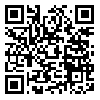Volume 13, Issue 1 (6-2021)
2021, 13(1): 36-42 |
Back to browse issues page
Ethics code: IR.NKUMS.REC.1398.069
Download citation:
BibTeX | RIS | EndNote | Medlars | ProCite | Reference Manager | RefWorks
Send citation to:



BibTeX | RIS | EndNote | Medlars | ProCite | Reference Manager | RefWorks
Send citation to:
Poorbarat S, Ramezani Sani Gelyan N, Hoseinzadeh A, Shakouri P, Saeidi E, Haresabadi M. Research Self-Efficacy and Its Related Factors in Students of North Khorasan University of Medical Sciences. North Khorasan University of Medical Sciences 2021; 13 (1) :36-42
URL: http://journal.nkums.ac.ir/article-1-2291-en.html
URL: http://journal.nkums.ac.ir/article-1-2291-en.html
Salar Poorbarat1 

 , Nahid Ramezani Sani Gelyan2
, Nahid Ramezani Sani Gelyan2 

 , Amin Hoseinzadeh3
, Amin Hoseinzadeh3 

 , Pouyan Shakouri4
, Pouyan Shakouri4 

 , Ehsan Saeidi3
, Ehsan Saeidi3 

 , Mehdi Haresabadi *5
, Mehdi Haresabadi *5 




 , Nahid Ramezani Sani Gelyan2
, Nahid Ramezani Sani Gelyan2 

 , Amin Hoseinzadeh3
, Amin Hoseinzadeh3 

 , Pouyan Shakouri4
, Pouyan Shakouri4 

 , Ehsan Saeidi3
, Ehsan Saeidi3 

 , Mehdi Haresabadi *5
, Mehdi Haresabadi *5 


1- Student Research Committee, North Khorasan University of Medical Sciences, Bojnurd, Iran
2- BSc in Public Health Student, Student Research Committee, North Khorasan University of Medical Sciences, Bojnurd, Iran
3- BSc in Nursing Student, Student Research Committee, North Khorasan University of Medical Sciences, Bojnurd, Iran
4- Medical Student, Student Research Committee, North Khorasan University of Medical Sciences, Bojnurd, Iran.
5- Instructor of Community Health Nursing, Department of Nursing, School of Nursing and Midwifery, North Khorasan University of Medical Sciences, Bojnurd, Iran ,mehdiharesabadi@gmail.com
2- BSc in Public Health Student, Student Research Committee, North Khorasan University of Medical Sciences, Bojnurd, Iran
3- BSc in Nursing Student, Student Research Committee, North Khorasan University of Medical Sciences, Bojnurd, Iran
4- Medical Student, Student Research Committee, North Khorasan University of Medical Sciences, Bojnurd, Iran.
5- Instructor of Community Health Nursing, Department of Nursing, School of Nursing and Midwifery, North Khorasan University of Medical Sciences, Bojnurd, Iran ,
Abstract: (3359 Views)
Introduction: Research self-efficacy can be expressed as people's judgments about their research abilities to organize and execute a series of tasks to achieve the specified research functions. Therefore, this study was conducted to evaluate students' research self-efficacy of North Khorasan University of Medical Sciences.
Methods: The present study was a cross-sectional study performed on 240 students of North Khorasan University of Medical Sciences. Students were selected by stratified random sampling. The students 'demographic information questionnaire and students' research self-efficacy questionnaire were used to collecting data. Data analysis was performed by SPSS20 software using descriptive statistics (including mean, standard deviation frequency, and percentage) and inferential statistics.
Results: According to the study results, the frequency of female students was 155 (66.8%). The mean and standard deviation of the age of students was 22.2±3.6 years. The mean and standard deviation of total self-efficacy is 151.24 ± 36.02, mean and standard deviation of statistical and analytical self-efficacy metrics 32.22 ± 10.25, self-efficacy in conceptualization 35.52 ± 8.99, self-efficacy in the method and implementation 31.41 ± 7.05, self-efficacy in qualitative research 3 12.59±4.9, reporting self-efficacy was 18.69 ± 5.76, self-efficacy in skills and proficient was 15.66 ± 3.64, and self-efficacy in ethics was 9.38 ± 2.86.
Conclusions: This study showed that research self-efficacy is moderate, and appropriate educational interventions are needed to promote it.
Methods: The present study was a cross-sectional study performed on 240 students of North Khorasan University of Medical Sciences. Students were selected by stratified random sampling. The students 'demographic information questionnaire and students' research self-efficacy questionnaire were used to collecting data. Data analysis was performed by SPSS20 software using descriptive statistics (including mean, standard deviation frequency, and percentage) and inferential statistics.
Results: According to the study results, the frequency of female students was 155 (66.8%). The mean and standard deviation of the age of students was 22.2±3.6 years. The mean and standard deviation of total self-efficacy is 151.24 ± 36.02, mean and standard deviation of statistical and analytical self-efficacy metrics 32.22 ± 10.25, self-efficacy in conceptualization 35.52 ± 8.99, self-efficacy in the method and implementation 31.41 ± 7.05, self-efficacy in qualitative research 3 12.59±4.9, reporting self-efficacy was 18.69 ± 5.76, self-efficacy in skills and proficient was 15.66 ± 3.64, and self-efficacy in ethics was 9.38 ± 2.86.
Conclusions: This study showed that research self-efficacy is moderate, and appropriate educational interventions are needed to promote it.
Type of Study: Orginal Research |
Subject:
Basic Sciences
Received: 2020/10/4 | Accepted: 2021/01/10 | Published: 2021/06/20
Received: 2020/10/4 | Accepted: 2021/01/10 | Published: 2021/06/20
Send email to the article author
| Rights and permissions | |
 |
This work is licensed under a Creative Commons Attribution-NonCommercial 4.0 International License. |





